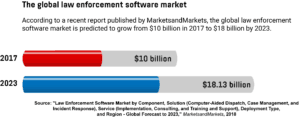- CATT is an algorithm designed to catch online sexual predators
- Traffic Jam uses AI to help the police fight human trafficking
- Could digital lie detectors replace polygraphs?
- UK police plans to use AI to predict violent crime
- How will AI affect the future of law enforcement?
Artificial intelligence (AI) has been on everyone’s lips lately, and for good reason. The technology is constantly finding new applications and has already transformed a number of industries, including healthcare, communications, automotive, and financial, with others set to follow in the near future. Given the stakes involved, it may not be particularly surprising that law enforcement has somewhat lagged behind other sectors when it comes to the adoption of artificial intelligence. However, that’s slowly starting to change, with law enforcement agencies around the world increasingly turning to AI to help them fight crime. A recent report published by MarketsandMarkets estimates that the global law enforcement software market will grow from $10 billion in 2017 to $18 billion by 2023.
CATT is an algorithm designed to catch online sexual predators
Online chatrooms can be a dangerous place, especially for children. They’re often frequented by pedophiles, who will try to initiate a conversation with unsuspecting children or even get them to agree to meet with them in person, which can lead to sexual assault. To address this issue and help police officers catch sexual predators before they do any harm, a team of researchers from Purdue University, led by assistant professor Kathryn Seigfried-Spellar, developed an algorithm called the Chat Analysis Triage Tool (CATT), which can identify sex offenders most likely to arrange face-to-face meetings with potential victims by analysing their word usage and conversation patterns.
To develop the algorithm, the researchers first examined more than 4,300 messages from 107 online chat sessions that involved sex offenders, using a process called statistical discourse analysis to identify different trends in word usage. “We went through and tried to identify language-based differences and factors like self-disclosure,” explains Seigfried-Spellar. “If we can identify language differences, then the tool can identify these differences in the chats in order to give a risk assessment and a probability that this person is going to attempt face-to-face contact with the victim. That way, officers can begin to prioritize which cases they want to put resources toward to investigate more quickly.”
Traffic Jam uses AI to help the police fight human trafficking
According to the International Labour Organization, 40.3 million people around the world were trapped in modern slavery in 2016, with one in four of them being children. More than half of them, 24.9 million, were trapped in forced labour, 4.8 million of which were in forced sexual exploitation. To address this issue and help the police find victims of human trafficking, a startup called Marinus Analytics developed Traffic Jam, a software suite that uses AI to comb the internet for escort ads and create a database of photos, phone numbers, and location data.

“Every day, tens and even hundreds of thousands of escort ads are posted online,” says Emily Kennedy, the founder and chief executive of Marinus Analytics. “We scrape the top escort sites and put them into Traffic Jam to make them searchable. The goal is to take all of the massive amount of data on the internet that’s relevant and turn it into actionable intelligence.” There are now more than 210 million ads in the Traffic Jam database. The websites are scraped every 20 minutes, which means that even ads that have since been deleted will be included in the database.
The company also recently added a new facial recognition feature called Facesearch. Based on Amazon’s Rekognition software, Facesearch allows police officers to upload a photo of a missing person and compare it against other photos in the database to find out whether they’ve been advertised before. According to Kennedy, Traffic Jam can significantly speed up police work, reducing investigation time by as much as 50 per cent. Widely used by law enforcement agencies across the United States, Canada, and the United Kingdom, Traffic Jam helped identify an estimated 3,000 victims of sex trafficking in 2018 alone.
Could digital lie detectors replace polygraphs?
The polygraph is a staple of crime TV shows and movies, allowing fictional detectives to determine without a doubt whether a suspect is telling the truth. In real life, though, things are a bit more complicated. Polygraphs are designed to measure physiological factors like blood pressure, heart rate, breathing rate, and perspiration as a person of interest answers a series of questions, with elevated values considered indicative of lying. However, the mere act of being subjected to interrogation can make someone feel nervous and produce a false positive. Furthermore, a trained individual can fool a polygraph, which is why polygraphs are generally not admissible as evidence in criminal cases. But could there be a better, more reliable way to get to the truth?
Developed by the Utah-based company Converus, EyeDetect is digital lie detection system that aims to determine whether a person is lying or telling the truth by measuring subtle changes in the eye, including pupil diameter, eye movement, reading behavior, blinks, and fixations. Using an infrared camera and a complex algorithm, it will assign each person a credibility score to show the probability they were truthful. “You can’t see it with the naked eye, but (pupils) dilate up to a tenth of a millimeter,” explains Converus’ CEO Todd Mickelsen. “We have tools … that allow us to capture those changes during our computer-based test.” According to the company, EyeDetect is cheaper, faster, more reliable, and less intrusive than a polygraph. Primarily used by companies to screen potential hires since it was first launched in 2014, the system was recently updated to allow it to be used in criminal investigations as well.
Although it’s typically not admissible in court either, at least not yet, EyeDetect can be a very useful tool in the course of a criminal investigation. “(This tech) is good enough for us to be able to steer (the investigation) in one direction or another,” says Sgt. Spencer Cannon with the Utah County Sheriff’s Office. “It may give us cause to open a new line of questioning that we had had [sic] reason to before … or give a person an opportunity to maybe come clean about something.” According to the company, the system is now being used by more than 500 clients in 42 countries around the world, with tests administered in 40 different languages.
UK police plans to use AI to predict violent crime
What if there was a way to predict potential criminal activity and step in before anyone gets hurt? That’s the idea behind a new system developed by the UK police, which aims to use a combination of AI and statistics to calculate the probability that someone will commit or become a victim of violent crime. However, rather than being arrested, individuals flagged by the system will be provided support in the form of counselling with local health or social workers.
https://www.youtube.com/watch?v=7Ly7yAzLDjA
The National Data Analytics Solution (NDAS), as the system is called, was developed by gathering more than a terabyte of data from several local and national police databases. This data contained information on more than 5 million individuals, including when they were stopped and searched by the police and the crimes they committed. The software then analysed the data to identify nearly 1,400 indicators that could be used to predict crime, such as the number of crimes an individual committed with the help of others and the number of crimes committed by people in that individual’s social group. Using these indicators, NDAS will attempt to identify individuals who are displaying similar behaviour that led to criminal activity in the past and assign each with a risk score that indicates how likely they are to reoffend.
Unsurprisingly, the idea of predictive policing has attracted a great deal of controversy, with the majority of opponents citing serious ethical issues associated with the use of such technology. Some have also voiced concerns about potential bias in the data used to train the system, which could result in biased predictions and lead the police to focus their efforts on certain communities, while leaving other communities underprotected. These concerns are unlikely to prevent the rise of predictive policing, though, with reports coming out that countries like the US, China, Denmark, Germany, and the Netherlands have all deployed or tested predictive policing tools in recent years.
How will AI affect the future of law enforcement?
Law enforcement is an activity that relies heavily on the collection and processing of information to prevent and control crime. However, as there’s only so much information a human can process at any given time, investigations often proceed slowly and are quite susceptible to human error, which makes law enforcement a prime candidate for the adoption of artificial intelligence.
AI offers unparalleled ability to analyse massive amounts of data in a short amount of time and identify patterns that may be imperceptible to humans, leading many law enforcement agencies around the world to start experimenting with using AI for crime-fighting purposes. Whether it’s used to catch online sexual predators, identify victims of human trafficking, determine whether a person is lying, or even predict crime before it happens, artificial intelligence certainly has the potential to make the world a much safer place, but we need to proceed with caution and make sure to address any outstanding concerns before we put our fate into its hands.
Share via:



